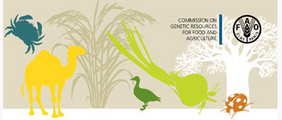Hans-Jörg Lehmann, the permanent representative of Switzerland at FAO, opened the side event and stressed the need for both public and private players to cooperate on the conservation and sustainable use of plant genetic resources.
Alexander Müller, Assistant Director-General, Natural Resources Management and Environment Department at FAO, mentioned that tackling food security requires biodiversity at the gene, species, and ecosystem level: Organic farms need biodiversity in order to compensate the prohibition of synthetic inputs. “With climate change, purely science based research can no longer solve the problems arising on the farm; a science of diversity is the best strategy to manage risks and cope with uncertainties,” said Müller. To this end, FAO, with a number of partners such as FiBL, is currently developing the Organic Research Centres Alliance ORCA. ORCA intends to network existing scientific institutions and to empower them to become centres of excellence in organic agricultural research.
According to FiBL director Urs Niggli, biodiversity is important for the stability of agro-ecosystems. “Risk management on organic low-input farms means optimizing biodiversity on all levels - gene, species, and landscape. This is also the best way for farming systems to adapt to climate change,” said Niggli. On-farm & in-situ conservation, breeding, and production is more important than ever as it allows many varieties and cultivars to be maintained for future needs, and at the same time they are exposed to environmental stress and allowed to adapt. His conclusions centred around the need for more research - on functional biodiversity in order to improve productivity of organic farms and on mixtures of varieties or of cereal and grain legumes to increase yield stability and quality. Furthermore he stressed the importance of selection programmes based on heirloom varieties and breeds.
Christina Grandi, the IFOAM liaison officer to FAO, said that at the recent IFOAM conference on Organic Animal and Plant Breeding, participants had called for the development of varieties adapted to low-input systems. Kesang Tshomo from the Organic Programme of the Bhutan Ministry of Agriculture spoke about organic collection, cultivation, and processing of medicinal, aromatic, and natural dye plants for household food security. Maria Grazia Mammuncini of the Tuscany Agency of Rural Development presented the experience in Tuscany with local breeds and varieties.
Hans-Jörg Lehmann concluded that biodiversity is an important driver for the stability of agro-ecosystems and hence, for a continuously stable supply of food. Elements for success of the conservation and sustainable use of plant genetic resources are, according to Lehmann, strong political support, innovative instruments in the areas of legislation, cost sharing, and market development. Public-private partnerships play an important role in this process.
More information
Contact
- Urs Niggli, Director, FiBL, Frick
Presentations
- Hans-Jörg Lehmann: Growing genetic resources in organic agriculture (874.3 KB)
- Urs Niggli: Contribution of organic agriculture to in-situ conservation of plant and animal resources, and risk management in agro-ecosystems (2.3 MB)
- Kesang Tshomo: Organic collection, cultivation and processing of medicinal, aromatic and natural dye plants for household food basket security (3.1 MB)
- Maria Grazia Mammuccini: Razze e varietà locali: esperienze dalla Toscana per considerare i bisogni degli agricoltori (326.2 KB)
Links
- FAO.org: FAO Commission on Genetic Resources for Food and Agriculture, 12th regular session
- FAO.org: Organic agriculture
- FAO.org: Organic agriculture/ORCA
- IISD.ca: Information on the Twelfth Regular Session of the Commission on Genetic Resources for Food and Agriculture at the website of theInternational Institute for Sustainable Development
- www.fao.org
- www.ifoam.org
- www.fibl.org





